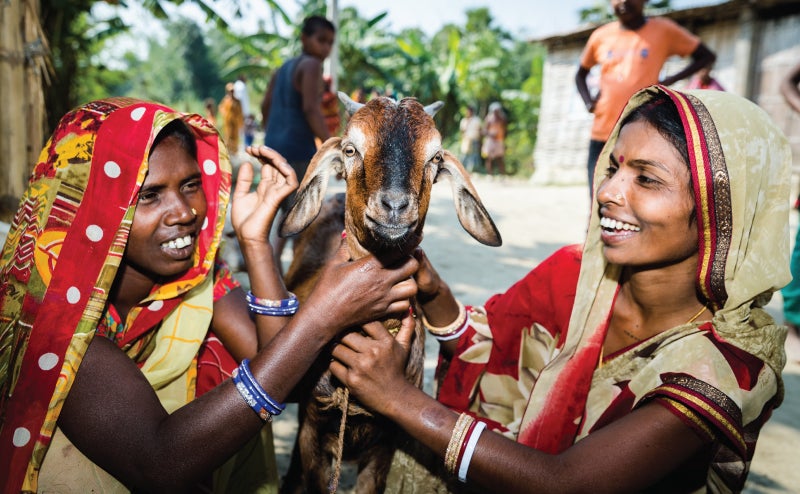The current process for diagnosing Alzheimer’s is a huge hurdle standing in the way of a breakthrough.
More and Better Crops
With support from the foundation, six nonprofit agricultural development organizations are helping hundreds of thousands of poor farmers in Sub-Saharan Africa and South Asia grow more productive, profitable, and sustainable crops.
Three-quarters of the world’s poorest people rely on farming small plots of land to feed themselves and their families. Helping these small farmers grow more crops and get them to market can have a tremendous impact on reducing hunger and poverty and associated problems.
But it’s a complicated challenge that requires support and investments across the agricultural value chain—from cultivating better seeds and soil conditions to improving farm management, access to markets, and government policies.
In 2008, we announced $306 million in grants to six organizations to help poor farming families in Sub-Saharan Africa and South Asia boost their productivity, increase their incomes, and improve their lives. When we announced the grants, I promised to post annual updates about the projects as a way to share the progress, setbacks, and lessons of our work in agricultural development.
Looking at the 2010 updates that have just been posted to the foundation website, I’m amazed at the life-changing results that our grantees have achieved in such a short time. In the last year, these organizations have touched the lives of hundreds of thousands of farmers and they are on track to help more than 5 million farming families in the years ahead.
Highlights From the 2010 Updates
In many parts of India and Africa, small farmers rely solely on rainwater to grow their crops and can produce barely enough food for their own subsistence. International Development Enterprises (IDE) last year worked with 731 agricultural equipment dealers to make affordable small-scale irrigation systems available to more than 100,000 farmers. IDE also helped about 12,000 farmers secure microfinancing to pay for the new systems. As a result, these small-farm families have been able to produce and sell surplus crops and increase their incomes by an average of $600 per year—enough to pay for school, healthcare, and invest in their farms.
The International Rice Research Institute (IRRI) is making steady progress toward its goals of providing 400,000 farmers with heartier varieties of rice that can withstand drought, flood, extreme cold, and harsh soil conditions. IRRI has trained more than 750 scientists in rice breeding and crop management, developed more than 200 new varieties of stress-tolerant seeds, and distributed over 6,500 tons of seed to farmers in the last year. And through a process called “participatory variety selection,” IRRI gets farmers directly involved in developing rice varieties that will grow best under local conditions.
In 2009, TechnoServe used its foundation grant to help provide 67,000 small-holder coffee growers in East Africa with access to equipment that enables them to process their beans into high-quality coffee. TechnoServe also helped train thousands of farmers in sustainable agronomy practices, and how to evaluate the quality of their coffee beans.
Working in Bangladesh, CARE organized more than 15,400 dairy farmers into groups that can collectively buy better feed and receive training in animal husbandry to produce larger amounts of higher-quality milk from their cows. Largely because of a sudden drop in demand for fresh milk in Bangladesh, CARE managed to link only about 5,400 farmers—a quarter of its target—to refrigeration facilities where they could store surplus milk for sale. But the organization met its goal of deploying 120 community veterinary workers, and more than 4,400 local dairy farmers used artificial insemination services provided by CARE.
In East Africa, more than 47,000 dairy farmers received help from Heifer International to form business associations and establish chilling plants that will help get the farmers’ milk to market. Although Heifer was able only to secure financing for five new chilling plants instead of 23 as planned, the new and existing plants helped farmers sell more than 118,000 liters of milk per day, more than we had expected. Heifer also helped local breeding services perform more than 56,000 artificial inseminations and is investigating new approaches to substantially increase that number in the next two years.
In Kenya and other sub-Saharan countries, the Alliance for a Green Revolution in Africa (AGRA) is bringing affordable fertilizers and training in integrated soil fertility management techniques to farmers. Although the start of these projects was delayed in 2008 because of political unrest in Kenya and rising fuel costs, AGRA has begun to make progress in helping farmers adopt more environmentally sustainable farming practices.
The annual progress reports on these organizations enable us to see what’s been working well in each program, and to adjust our strategies to address unexpected challenges and to adapt to the evolving needs of local communities and individual farmers. I’m encouraged by the strides that our nonprofit partners and the farmers are making through these programs despite challenging conditions. At the same time, I see how much more needs to be done.
Since 2006, the foundation has committed more than $1.5 billion in grants to support agricultural development efforts. The G8 and G20 nations have committed $22 billion to food security over three years and African countries and leaders are also making big increases in their domestic investment in agriculture.
This renewed attention to agricultural development is important. We know that better farming is the most important solution for overcoming hunger and poverty, and that the investments the foundation and others are making can have an incredible impact in a relatively short period of time.




